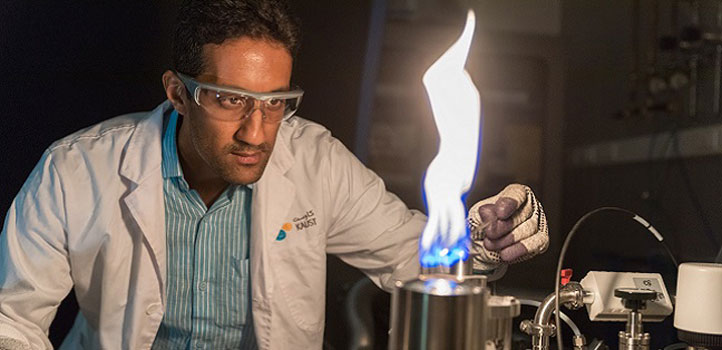
10 January, 2018
The transition to renewables will take decades, so we must rush to clean up conventional fuel combustion, says Mani Sarathy.

Mani Sarathy researches alternative fuels and collaborates with atmospheric scientists to understand the fate of exhaust emissions in the air. © KAUST 2017
Fuel combustion chemist Mani Sarathy began his research career as an environmental engineer studying the environmental impact of pollution. But before long, Sarathy realized that the most effective way to mitigate environmental damage was to stop pollution at its source. Sarathy tells us, “I got into combustion research to look at how we could maximize engine efficiency and minimize exhaust emissions to improve the environment.”
In the five years since joining the Clean Combustion Research Center at KAUST, the Associate Professor has tackled combustion science from a diverse range of angles. As well as studying the fundamental chemistry and physics of fuel combustion1 and feeding that knowledge into improved engine design, Sarathy researches alternative fuels2 and collaborates with atmospheric scientists to understand the fate of exhaust emissions in the air. He, together with colleagues, is even beginning to harness artificial intelligence and machine learning to improve combustion processes.
Sarathy acknowledges that burning fossil fuels depletes resources and generates emissions that impact the climate and environment. “But the fact is, society is heavily invested and reliant on this technology. Transitions to renewable energy sources are needed, but we need more time for these technologies to develop,” explained Sarathy. In the automotive sector alone, it is predicted it will take another 25 years to fully phase out gasoline-powered vehicles. Sarathy then points out, “And that still leaves trucks, heavy-duty machinery, ships and aircraft.” All of which provide plenty of motivation to pursue clean combustion research.
When Sarathy joined KAUST in 2012, part of the appeal was that most of the key players in the energy industry are right on the doorstep: from fuel and petrochemical companies to vehicle-engine manufacturers, gas-turbine manufactures and aerospace companies. “The opportunity was there to work with industry on real problems,” Sarathy says. It’s an opportunity he embraced. “In most universities, you do your research and hope it may one day have some impact. Here, in just five years, you can see your fundamental research translated into something that immediately impacts society.”
But for Sarathy, joining KAUST in its formative years was an equally big drawcard. Previously, Sarathy worked at the world-renowned Lawrence Livermore National Laboratory in California, United States. “It was a well-established institution, but that meant it was harder to start anything new because you were working in an existing system and meeting requirements for existing long-term government programs,” he says. “But then the opportunity came up in KAUST and here you have a blank slate. What you write on that blank slate is up to you.”
Today, Sarathy maintains a core research focus on combustion chemistry but also claims a diverse portfolio of clean combustion research projects. “If you have a vision, and the science to back it up, KAUST will support you,” he explains. “We can use our funding to develop new collaborations with people around the world to start new areas of research.”
The latest example is the collaboration he established with atmospheric scientists Mikael Ehn and Matti Rissanen from the University of Helsinki in Finland. Sarathy tells us, “We can use our understanding of how hydrocarbons are oxidized in the engine to help atmospheric chemists understand how organic compounds are oxidized in the atmosphere. Until now, there has been almost no collaboration between combustion scientists and the environmental scientists who monitor the impact of emissions on the environment. “If we can bring the two groups together, maybe we can develop new technological solutions to improve air quality and limit climate change.”
Over the years, Sarathy and his colleagues have gathered reams of data on the fundamental physics and chemistry of combustion and they’re still gathering. They’ve put that data, along with cloud-based simulation tools, on to a web portal called CloudFlame, which has over 1500 users from over 80 different countries. “We built the website to democratize combustion science and provide everyone with access to the same tools and data that leading companies and universities have,” he says.
His next aim is to bring machine-learning scientists into the combustion research field. “If you have good algorithms and a lot of data, you let the computers learn on their own, and they might discover entirely new ways to solve a problem,” he says.
“And thanks to KAUST’s growing reputation, when you contact the best people, they’re keen to collaborate.”
Sarathy, S.M., Osswald, P., Hansen, N. & Kohse-Hoeinghaus, K. Alcohol combustion chemistry. Progress in Energy and Combustion Science 44, 40–102 (2014).| article
Zhang, B. & Sarathy, S. M. Lifecycle optimized ethanol-gasoline blends for turbocharged engines. Applied Energy 181, 38-53 (2016).| article

"KAUST shall be a beacon for peace, hope and reconciliation, and shall serve the people of the Kingdom and the world."
King Abdullah bin Abdulaziz Al Saud, 1924 – 2015
Thuwal 23955-6900, Kingdom of Saudi Arabia
© King Abdullah University of Science and Technology. All rights reserved